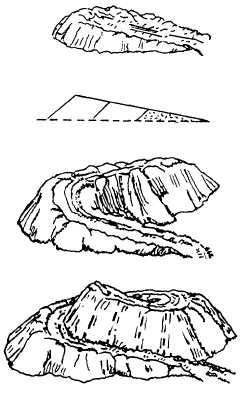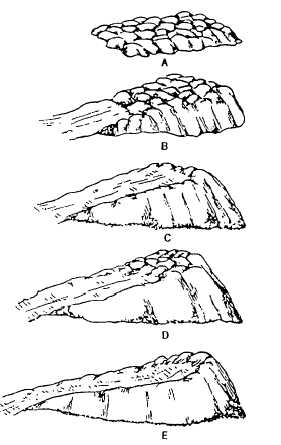When packing by trucks does not cause damage to
the material, a pile can be smoothed off with a dozer,
and one or more additional layers can be added. Factors
limiting the maximum height are the slope in from the
edges and the gradual grade for the truck ramp. Figure
6-13 illustrates the building of a stockpile by backing
trucks upon the ramp and building it up in layers. Ramp
grade should not be so steep as to strain the truck or to
prevent them from dumping cleanly.
Figure 6-14 illustrates the building of a stockpile by
use of a spiral ramp. This is started as a narrow, backup
pile that is spread on the outside far enough to protect
the ramp from caving in and well past the center on the
inside. The ramp, steadily rising, is turned and comes
back on the far side, parallel with the first section, but
above it. Material is still dumped far enough to the
outside and inside to protect the ramp.
When material is too soft or too loose to support
trucks, the ramps may be strengthened by the use of wire
mats, or small quantities of screening, soil, or other
binders if their use will not spoil the value of the
stockpile.
Figure 6-13.-Ramp stockpile.
Figure 6-14.-Spiral ramp stockpile.
Trucks may be kept off a stockpile, either for safety
measures or to avoid packing, by dumping on level
ground and piling by dozer or loader. The loader is more
efficient because it can combine lift with push for
higher, steeper piles with shorter moves and less power
consumption heaping stockpiles rapidly. The dozer is
entirely flexible in placing or varying the size and shape
of a stockpile and can be used for a variety of other work;
however, it must move its entire weight up the pile with
each load, and the constantly working tracks on the
dozer may be subjected to severe wear in sand or other
abrasive materials. Also, the tracks may pack or crush
soft materials that drastically reduces their value.
Choice of tracks or wheels depends on the
availability of equipment and the type of material.
Wheels provide more compaction and cause less
breakage into fines. They wear less in sand or gravel as
long as the operators avoid spinning the tires during
loading operations; however, wheels become
ineffective under slippery conditions.
Loaders of either type can be used to reclaim the
pile, loading the material into trucks or carrying it to
hoppers or to the area of use. Tires have an advantage
in both speed and economy for carries greater than 50
feet.
6-14




